Foxes are some of the most fascinating creatures on the planet, whether you think they’re cunning and deceitful or lovely and fluffy.
How much do you know about these wonderful canines, when there are approximately two dozen fox species on Earth right now?
What is a Fox?: How Foxes Are Classified

To categorize foxes, it’s a challenge. Foxes are classified within a number of genera, unlike other kinds of canines like wolves, which are mostly contained inside one genus.
The kingdom Animalia, the phylum Chordata, the class Mammalia, and the order Carnivora are all home to foxes. Canidae is a family of canids that includes them all. Foxes are canines, which are carnivorous animals that are often referred to as dogs or canids.
The classification of foxes, on the other hand, gets a little more complex beneath the Canidae family. Foxes are divided into six genera based on the 23 surviving species.
The true foxes belong to the biggest genus, Vulpes, which includes 12 of these species. Nonetheless, the South American foxes belong to the genus Lycalopex, which is the second-largest genus.
The remaining four genera encompass either one or two species, with several of them being more genetically akin to wolves, coyotes, and jackals than the other foxes.
The question of “what is a fox?” has a lot of layers to it. There is some uncertainty about all of the other species, despite the fact that most scientists believe true foxes and South American foxes to be actual foxes.
Finally, any small dog with triangular ears, a mostly flattened skull, a pointed snout, and a bushy tail is often referred to as a fox. The species are mostly omnivorous and active at night or crepuscular, although there are significant differences between them that it’s tough to classify.
Fox Facts

To some of your most frequently asked questions about foxes, here are our answers:
What is the Rarest Fox?
The Sierra Nevada red fox (Vulpes vulpes necator) is arguably the most endangered fox subspecies. It is estimated that just 50 Sierra Nevada red foxes remain. The San Joaquin kit fox, Darwin’s fox, Simien fox, and island fox are some of the rarest fox species in existence.
What Type of Foxes Live in North America?
Foxes come in a variety of shapes and sizes across North America. The red fox is the most common kind of fox. The swift fox, Arctic fox, kit fox, and gray fox are other North American Fox species.
What Are Baby Foxes Called?
Kits are how people refer to baby foxes, but pups or cubs are other names. Meanwhile, vixens and tods are the terms for female and male foxes, respectively.
What Do You Call a Black Fox?
An ordinary name for a silver fox is black fox. These foxes are not a distinct species. Silver foxes are actually melanistic red foxes, not silver foxes. As a result, their fur contains a lot of black melanin pigment. Their fur becomes black as a result of all the extra pigment.
Is a Fox a Dog?
A fox is a dog, in technical terms. The Canidae family of animals, which includes dogs, includes foxes as one of its members. Although a fox and a household dog are two very different species, they are closely related.
Can Foxes Mate With Dogs?
Domestic dogs and foxes can’t breed. Because of the significant differences in chromosome counts between these two kinds of canines, this is the case. The red fox has 34 chromosomes, whereas the domestic dog has 78. As a result, they are unable to create normal children. Wolf chromosomes, on the other hand, are 78 in number, allowing for dog-wolf combinations.
The 23 Ferocious Types of Foxes

We’ll give you a better look at the fox world and show you each of the 23 types of foxes in detail. Learn about the different types of foxes and their characteristics.
Apart from Antarctica, there are 23 distinct species of foxes that call all continents home. The Canidae family, which includes all canines, contains all of these foxes.
Triangular ears, flattened heads, pointed snouts, and a long fluffy tail are all characteristics of foxes. Yet, there are significant genetic disparities between the fox species.
There are six living genera of foxes, with 23 species and dozens of subspecies classified into them. Here’s a overview of each kind of fox and what distinguishes them.
1. Genus Vulpes
All of the animals that are known as true foxes belong to the first fox genus, Vulpes. In comparison to other canines, true foxes are generally smaller.
Using fossil records, researchers have found 12 current species of foxes and at least four extinct species. Each of the twelve different types of actual foxes that live on Earth has something important to tell you.
1.1 Bengal Fox

The Bengal fox (Vulpes bengalensis) is the first animal on our list. The Bengal fox, also known as the Indian fox, lives exclusively in the subcontinent south of the Himalaya.
Although it has a particularly bushy tail that may account for up to 60% of its body length, it is one of the smallest true fox species. Small animals, including lizards, insects, birds, and rabbits, are eaten by the majority of Bengal foxes. Egg and fruit eating are also habits of these opportunistic feeders.
The International Union for Conservation and Nature (IUCN) has designated the Bengal fox as a species of low concern. Nevertheless, owing to a combination of factors including large-scale habitat destruction, hunting, and canine distemper illnesses, its population is declining.
1.2 Blanford’s Fox

The Blanford’s fox (Vulpes cana) is a small canine that lives in parts of the Middle East and southwestern Asia and is named for the English naturalist William Thomas Blanford.
Since it is only found in Iran, Pakistan, and Turkmenistan, the species has an fascinating range. Yet, in Saudi Arabia, Yemen, Oman, and the United Arab Emirates, it is also found in small populations.
The sandy desert climates that it calls home are ideal for hiding among Blanford’s foxes, who are brownish-grey in hue. The IUCN has classified the species as a least concern because of its stable population. Nonetheless, long-term dangers, the majority of which are human development and hunting, continue to threaten the species.
1.3 Cape Fox

The Cape fox (Vulpes chama) is a small canine that can be found throughout southern Africa and is also known as the silver-backed fox or the cama fox. Surprisingly, it is the sole sub-Saharan African species that is a true fox. South Africa, Angola, Namibia, Botswana, and perhaps both Lesotho and Eswatini are now part of the species’ range.
Small mammals like field mice, hares, and other small rodents are the preferred food of the Cape fox. Steenbok and even domestic sheep have been known to be eaten by them. Honey badgers, black-backed jackals, and caracals, as well as other large cats like lions and African leopards, prey on this species one step lower down the food chain.
The IUCN has designated the Cape fox as a “species of least concern,” despite the fact that it is extensively hunted and persecuted by humans. Throughout its vast range, the species has a fairly steady population. In addition, human development is not posing a significant threat to its preferred habitat (savanna and shrublands).
1.4 Corsac Fox
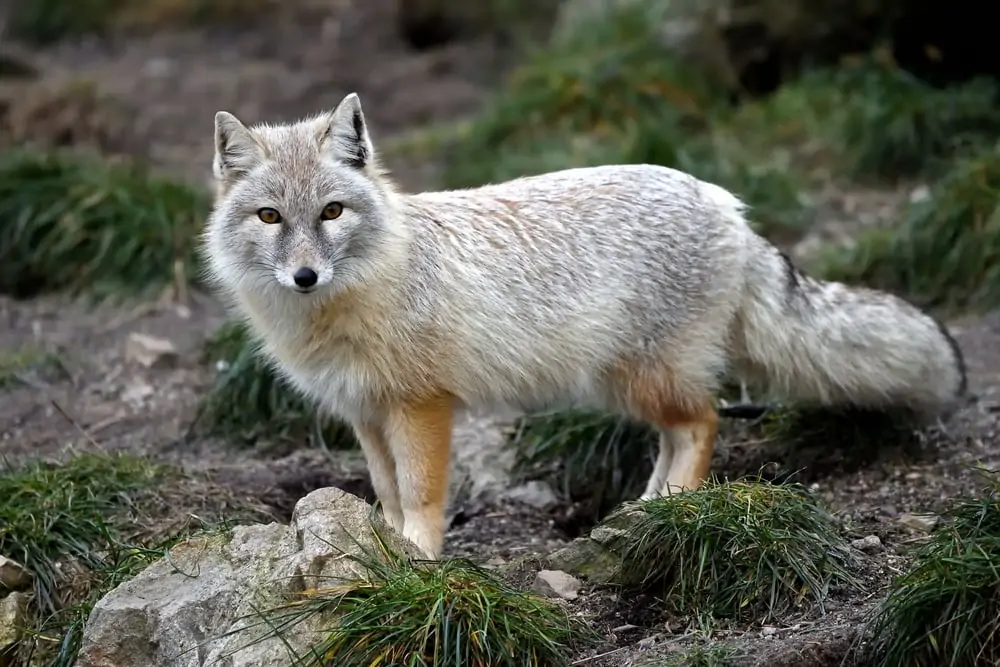
The Corsac fox (Vulpes corsac) is a common fox that can be found across Central Asia. In nations like Mongolia, Russia, Uzbekistan, Kazakhstan, and even northern Iran, this fox prefers to dwell in semi-desert and steppe environments.
The dry environment of the Corsac fox suits it well, and it can live without water for extended periods. It’s a feeder that forms packs from time to time. Little rodents and mammals are the species’ preferred diet, but it will eat insects if needed. Corsac foxes are often eaten by gray wolves and even eagles because of their tiny size.
The Corsac fox is pursued for its fur across much of its range. Despite this, it is classified as a species of low concern with a relatively stable population. Habitat degradation caused by overgrazing by livestock is the species’ greatest danger, with much of its range afflicted by desertification.
1.5 Tibetan Sand Fox
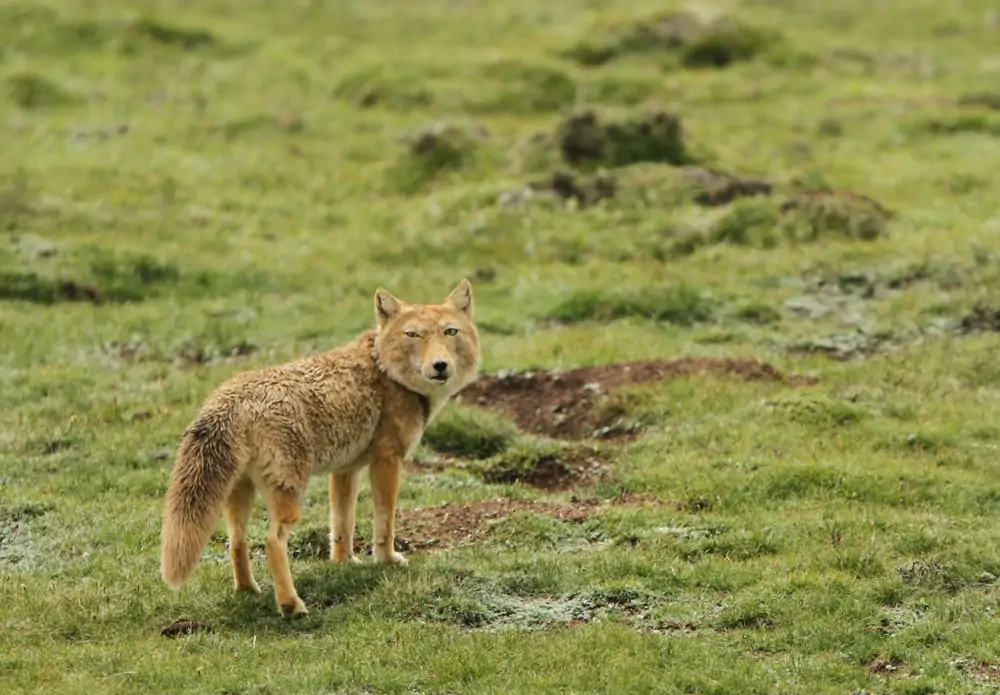
The little Tibetan dog Vulpes ferrilata lives on the Tibetan Plateau and is known for its elusive nature. Researchers believe the species can survive up to 17,400 feet (5,300 meters) in height on the dry steppes of Central Asia, despite the fact that very little is known about it.
In rural sections of southwestern China and northern India, the majority of Tibetan sand foxes dwell apart from major human development. Marmots, Plateau pika, and woolly hares are among the animals it preys on. Musk deer, Tibetan antelope, and blue sheep carcasses are also known to be scavenged.
While the Tibetan sand fox’s large range is primarily why it is now designated as a species of least concern. After a photographer won The Guardian’s 2019 wildlife photography contest with a picture of a Tibetan sand fox hunting a marmot, the species became an internet sensation for a brief time.
1.6 Arctic Fox

The gorgeous Arctic fox (Vulpes lagopus) may be found throughout the northernmost reaches of the Northern Hemisphere and is arguably the most recognized fox species. It may be found in Svalbard, Greenland, northern Canada, and Arctic Russia, and it may be found practically everywhere in the Arctic. Further south, in Alaska’s Kenai Peninsula, the species may be found.
Moreover, in Iceland, the Arctic fox is the only indigenous land animal. Researchers believe that the species arrived in Iceland during the last glacial epoch, when the island was linked to other land masses via a enormous ice sheet.
The white winter fur coat of the Arctic fox is perhaps its most well-known feature. The white morph, which is virtually entirely white in the winter and remains a dark grey color year-round, is really divided into two color morphs: the blue morph.
1.7 Kit Fox

The kkit fox (Vulpes macrotis) is a little dog with huge ears that may be found throughout the southwestern United States and northern Mexico. In the Great Basin and Sonoran Desert, it prefers to dwell in semi-arid and arid environments.
Kit foxes, like other fox species, are omnivores and scavengers, but meat is their preferred source of food. Merriam’s kangaroo rats are the species’ primary food source, although black-tailed jackrabbits are also eaten.
The swift fox (Vulpes velox) and the kit fox are closely related, and there has been some interbreeding. The endangered San Joaquin kit fox (Vulpes macrotis mutica) lives exclusively in the San Joaquin Valley of California and is one of several kit fox subspecies.
1.8 Pale Fox
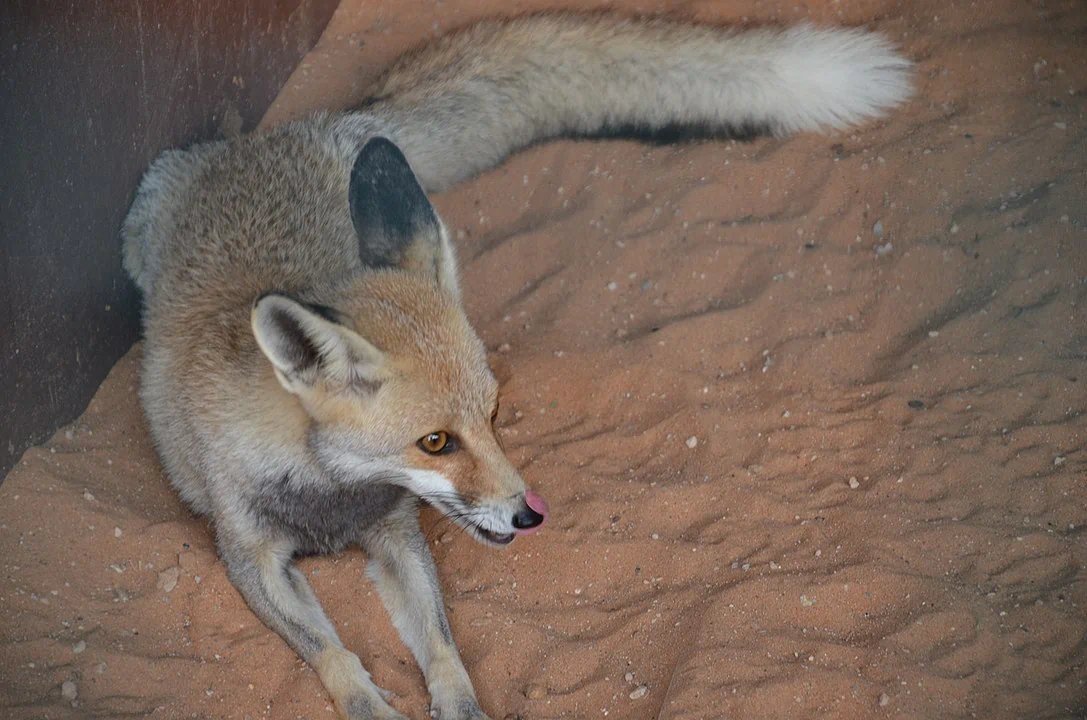
The little-studied Vulpes pallida is one of the world’s least-studied canines, and its name is fitting. It’s found between Sudan and Senegal in the African Sahel, a very lonely hideaway. The light color of the species’s fur blends in with desert sand when it prefers arid settings.
The pale fox is thought to have at least five subspecies, with the majority of them being identified by where they live. The small stature, short legs, and thin fur of all of the species are similar.
The IUCN has classified the pale fox as a species of lesser concern. Researchers estimate that the wild has anywhere from 10,000 to 100,000 individuals, but additional study is required to ascertain the species’ true range. In addition, the pale fox is threatened by habitat loss caused by agricultural and oil development.
1.9 Rüppell’s Fox

The Rüppell’s fox (Vulpes rueppellii) is a beige-colored canid with a worldwide range and named for German naturalist Eduard Rüppell.
While it may be found in the Arabian Peninsula and Iran, Israel, Jordan, and Syria, the species primarily lives in North Africa. The majority of Rüppell’s foxes dwell in dry and semi-dry places, eating everything from beetles to succulents.
Surprisingly, as a consequence of the fast desertification of North Africa and the Middle East, the Rüppell’s fox’s native range is expanding. Its range has expanded to new areas, including the Emirate of Abu Dhabi, where it finds refuge in the Al Hajar Mountains, despite its avoidance of intense heat.
1.10 Swift Fox

The swift fox (Vulpes velox) is a little canid found in the western Great Plains and southern Rocky Mountains of the United States and Canada, where it was previously threatened with extinction.
The orange-tan coat of the swift fox blends in well with the surrounding environment, making it prefer to live in short-grass prairies. Rabbits, insects, birds, and mice are among the foods it consumes, although carrion is also eaten.
The swift fox was practically wiped out in Canada and nearly destroyed in the United States between the 1930s and 1950s as a consequence of a broad predator extermination program that sought to eliminate coyotes and other wolf breeds. Despite the fact that the quick fox does not kill livestock, it was targeted during the initiative.
The swift fox population has been successfully stabilised since then thanks to a reintroduction program. In the United States, the species is no longer designated as endangered, and it is classified as a species of little concern by the IUCN.
1.11 Red Fox

The red fox (Vulpes vulpes) can be found all over the world, from the jungles of Southeast Asia to the Great Plains of North America. It is the most common fox species in the world.
In reality, red foxes are the most widespread canines on the planet. Much of North America, Europe, Asia, and northwestern Africa are native to this species. Although it has now become a conservation issue on the continent, it was also introduced to Australia by European colonists in the 1830s.
There are at least 45 subspecies of red foxes, despite the fact that they are all members of the same species, Vulpes vulpes. These subspecies range from the British Columbia red fox (V. macrotis) to the Himalayan red fox (V. rubicundus). v. The Palestinian fox (V. abietorum) is related to it. v. Palaestina is the name given to this region.
The IUCN classifies the red fox as a species of low concern due to its broad range. The fox, on the other hand, is one of the most severely persecuted canines. While others hunt the red fox for its soft fur, many people consider the species a pest.
1.12 Fennec Fox

The beautiful fennec fox (Vulpes zerda) is the last true fox species. This species thrives in extreme heat and lives in the Sahara Desert and Israel’s most arid regions.
The fennec fox’s large ears are a characteristic that allows it to lose heat, which is a unique ability. The fox’s ears also have a keen hearing capacity, allowing it to hear burrowing animals and other prey.
The fennec fox has an average weight of about 4.2 pounds (1.9 kg), according to many researchers, making it the world’s smallest canine. Due to its broad range, it is classified as a species of lesser concern. The fennec fox, on the other hand, is endangered by persecution and habitat destruction.
2. Genus Urocyon
The members of the genus Urocyon are closely related to the genus Vulpes, despite not being “true foxes.”
Surprisingly, the genus Urocyon contains two fox species that are considered to be the basic (root) of the whole canine family. All presently existing canines are thought to have originated from the genus Urocyon.
The two kinds of foxes in the genus Urocyon are discussed below.
2.1 Gray Fox

The gray fox (Urocyon cinereoargenteus) is a little dog that can be found across North and Central America. While the red fox has since displaced the grey fox as the principal wild canine in that area, it was formerly particularly common in the eastern United States. In the western part of the continent, the gray fox is currently more common.
The gray fox is a relatively easy to identify when compared to other types of foxes in its range. It has a black stripe down its back and tail, and it has a much more grizzled face. In addition, these canines prefer to dwell in woodlands. In reality, it’s one of the best-skilled tree-climbing foxes.
The gray fox is designated as a species of least concern by the IUCN, despite its constantly shifting habitat and human-caused threats. The gray fox, on the other hand, is home to at least 16 subspecies, some of which are endangered or endangered in certain areas.
2.2 Island Fox

The island fox (Urocyon littoralis) is one of the most interesting fox species in the world. Only six of the eight Channel Islands off the coast of southern California are home to this appropriately named species.
The island fox is a tiny dog species with a unique characteristic, which is attributed to its isolation from mainland gray foxes, according to several experts. The island fox has a gray fox-like appearance, but since it is the only canid in its area, it is difficult to mistake with other canids.
The island fox is divided into six subspecies. In the Channel Islands, each subspecies is found on a different island. The following are some of them:
- Urocyon littoralis clementae, or San Clemente Island
- Urocyon littoralis catalinae is a species of canid found on Santa Catalina Island.
- Urocyon littoralis dickeyi is a species of island fox.
- Urocyon littoralis santacruzae is a species of raccoon found on Santa Cruz Island.
- Urocyon littoralis santarosae is a species of island bear.
- Urocyon littoralis littoralis, also known as San Miguel Island.
While they possess both visual and genetic distinctions, scientists believe that all of the subspecies are capable of interbreeding.
The Santa Cruz Island subspecies, which has fewer than 100 individuals in the wild, is one of at least four subspecies classified as endangered in the United States. Due to the danger posed by imported diseases, the IUCN has classified the island fox as a whole as “near threatened.”
3. Genus Otocyon
The bat-eared fox is the only species in the genus Otocyon. The species of the genus Otocyon is thought to be a primitive (root) form of all canines, similar to the two forms in the genus Urocyon.
This species was previously classified as a kind of jackal, but it was subsequently reclassified as more closely related to foxes, according to researchers. The sole fox species in the genus Otocyon is this what you need to know.
3.1 Bat-Eared Fox
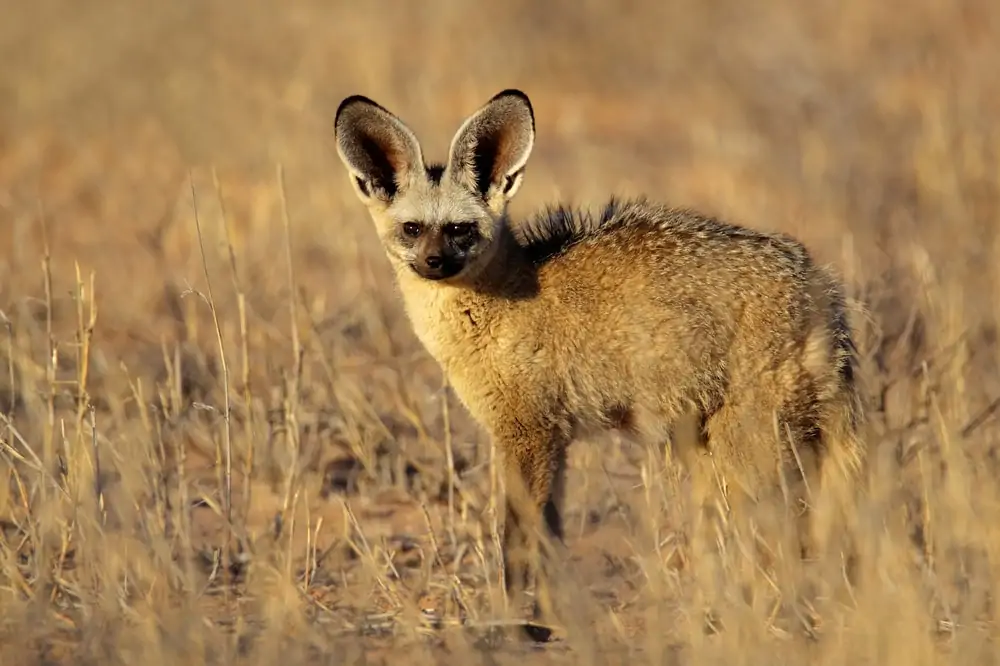
The bat-eared fox (Otocyon megalotis) is a little fox with enormous ears. The body is pale brown or black, with a tan-colored fur coat that fades to dark brown or black on the tail, limbs, and ears.
The bat-eared fox is distributed across the African savanna, and there are two recognized subspecies. One (Otocyon megalotis megalotis) is exclusively found in southern Africa, whereas the other (Otocyon megalotis virgatus) is exclusively found in eastern Africa.
According to the IUCN, the bat-eared fox is a species of lowest concern. Because of its large ears, the species is well-adapted to its arid environment and may dissipate body heat more efficiently and cool off in hot temperatures.
4. Genus Lycalopex
The genus Lycalopex has the greatest number of fox species of any genus after Vulpis. The English name for this group of animals is “South American foxes,” but the Spanish and Portuguese names are “zorro” and “raposa.”
The genus Lycalopex has the greatest number of fox species, following the genus Vulpis. In English, these species are referred to as “South American foxes,” although in Spanish and Portuguese, they are referred to as “zorro” and “raposa.”
South American foxes are represented by six species. Each species is briefly overviewed below.
4.1 Culpeo Fox

The culpeo fox (Lycalopex culpaeus) is the second-largest canid in South America, and is also known as the Andean fox. It thrives in its native environment on the many plateaus and montane deserts of western and southern South America, thanks to its reddish-gray color.
The culpeo fox is able to hunt some quite big prey because of its enormous size. It consumes rabbits and other tiny creatures, as well as young guanacos and even domestic animals, but it is known to consume them.
With a stable population, the culpeo fox is considered to be a species of low concern. While the Fuegian dog breed became extinct in the early twentieth century, it was formerly domesticated. Human hunting and imported diseases are now the greatest concerns for the species.
4.2 Darwin’s Fox

The Darwin’s fox (Lycalopex fulvipes) is a rare fox species that only lives in Chile’s isolated areas.
On Isla San Pedro off the coast of Chile in 1834, Charles Darwin, the namesake of Darwin’s fox, identified it. However, its primary population center is in the Nahuelbuta National Park area on Isla Grande de Chiloé.
A small dog with a black coat, the Darwin’s fox is a species in decline. It’s only found in temperate rainforests, and it’s estimated that maybe a few hundred to a few thousand specimens remain in the wild.
4.3 South American Gray Fox
The South American gray fox (Lycalopex griseus) is a slender canine that lives in the southernmost part of South America. It is sometimes referred to as the chilla or the Patagonian fox. In the early twentieth century, it was also brought to the Falkland Islands. On a few of the archipelago’s islands, there are still tiny fox populations.
The South American gray fox is rather big when compared to other foxes. It has a particularly thick fur coat and can weigh up to around 12 pounds (5.5 kg).
The South American gray fox is largely found in semi-arid areas, although it may also be found in woods and on the Patagonian steppe. Although the species as a whole is classified as “least concern,” its fur coat has long been hunted.
4.4 Pampas Fox
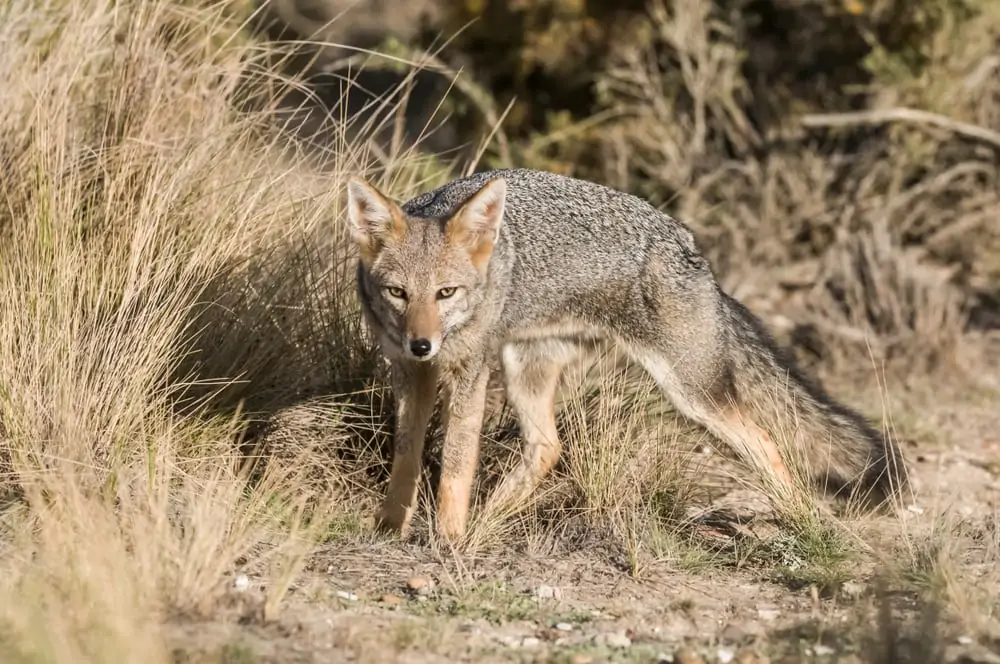
The Azara’s fox (Lycalopex gymnocercus), also known as the Pampas fox or Lycalopex gymnocercus, is a medium-sized dog that may be found across South America, as well as parts of Bolivia and Paraguay. Parts of northern Argentina, Uruguay, and the Brazilian state of Rio Grande do Sul are covered by the Pampas, a vast fertile lowland region.
The Pampas fox looks a lot like the culpeo fox in terms of physical appearance, despite its smaller size. The Pampas fox has five recognized subspecies, however experts disagree on their geographical ranges.
While the Pampas fox is a species of low concern, it is threatened by habitat degradation caused by large-scale agriculture in its range. For centuries, it has been hunted and trapped for its fur, as well as by farmers seeking to safeguard their animals.
4.5 Sechuran Fox

The Sechuran fox (Lycalopex sechurae) is one of the most uncommon canines in northern South America and is commonly referred to as the Peruvian desert fox. It can be found in the Sechura Desert, which is located in coastal Peru and Ecuador.
The Sechuran fox is nocturnal because of the harsh temperatures in its environment. It will eat fruits, seeds, eggs, and carrion, so it’s an opportunistic feeder as well.
The Sechuran fox is classified as “near-threatened” due to human development and habitat destruction. In addition, the creature has been persecuted for usage in folk medicine and livestock protection. In Peru, where a license is required to hunt the species, it is partially protected.
4.6 Hoary Fox

The hoary fox (Lycalopex vetulus) is the last species in the genus Lycalopex. Only central and western Brazil’s savanna environments support this endangered species, which is found only there.
The majority of hoary foxes have greyish-brown coats that are grizzled and short. Being a fox species, they are tiny and slender, yet the hoary fox is an agile hunter because to their small stature.
The hoary fox, like many other fox species in the area, is nocturnal and eats insects such as dung beetles and termites when given the opportunity, but it will also eat small rodents if given the chance. Agriculture and human development are posing a severe threat to the hoary fox’s habitat.
5. Genus Cerdocyon
Another single-species genus is Cerdocyon, which is also a monotypic genus. The crab-eating fox is the sole species found there. Members of the Lycalopex genus, as well as various wolf species, are closely related to it.
5.1 Crab-Eating Fox

The crab-eating fox (Cerdocyon thous) is a dog-like canid that lives in large swaths of South America and is also known as the maikong, wood fox, and bush dog.
The crab-eating fox is easily distinguished from other South American foxes, despite sharing a range with a number of species in the genus Lycalopex. It has a largely grayish-brown coat with short, thick hairs, which makes it particularly huge for a fox.
Crab-eating foxes may dwell in subtropical woods to savannas and are accomplished hunters. It is a species of least concern with a reasonably constant population, despite the fact that it is vulnerable to invasive species and imported diseases.
6. Genus Canis
The genus Canis contains the final fox species, the Simien fox. Because it belongs to a genus that also includes coyotes, golden jackals, domestic dogs, and all sorts of wolves, taxonomists are divided on whether this species is truly a fox. These are the key points to consider.
6.1 Simien Fox
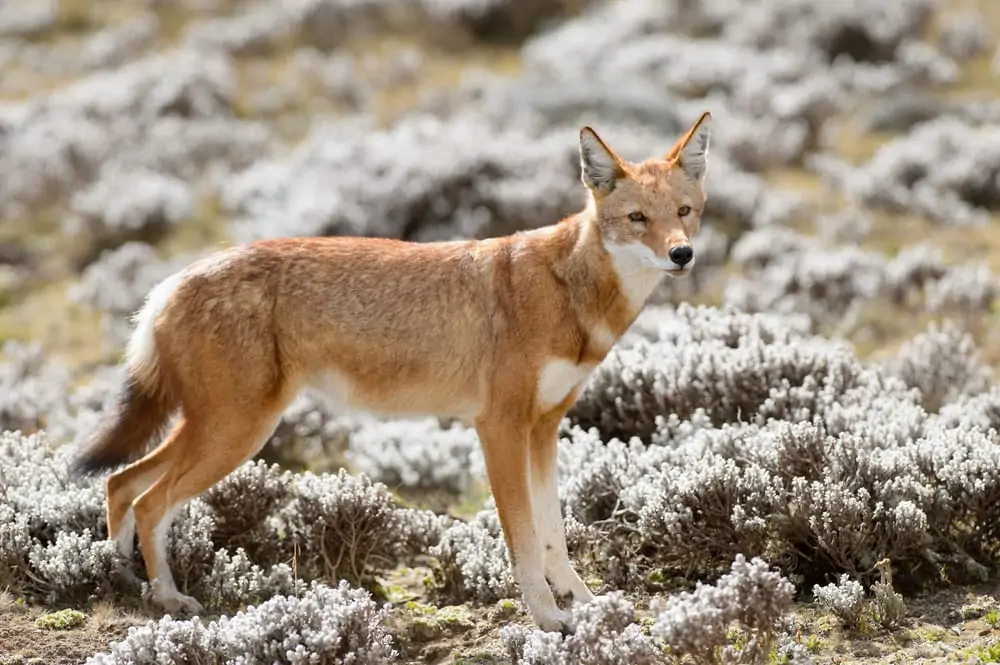
The Ethiopian wolf or Simien jackal are two names for the same species, the Simien fox (Canis simensis).
Despite its genetic similarities, however, most scientists believe the Ethiopian wolf is not a wolf. In addition, the Simien fox looks more like a coyote than a fox in terms of structure.
Unfortunately, in this article, we can’t resolve the taxonomic disagreement. We’re happy to include the Ethiopian wolf on our list of different types of foxes, since many people believe it is a fox.
Sadly, this article can’t help with the taxonomy squabble. Yet, we’re happy to include the Ethiopian wolf on our list of different types of foxes since many people believe it is a fox.
One of the most endangered fox species is the Simien fox. The IUCN has classified it as an endangered species across its range. In Ethiopia, the species thrives in shrublands and high elevations, but habitat loss and alien diseases are decimating the population.
